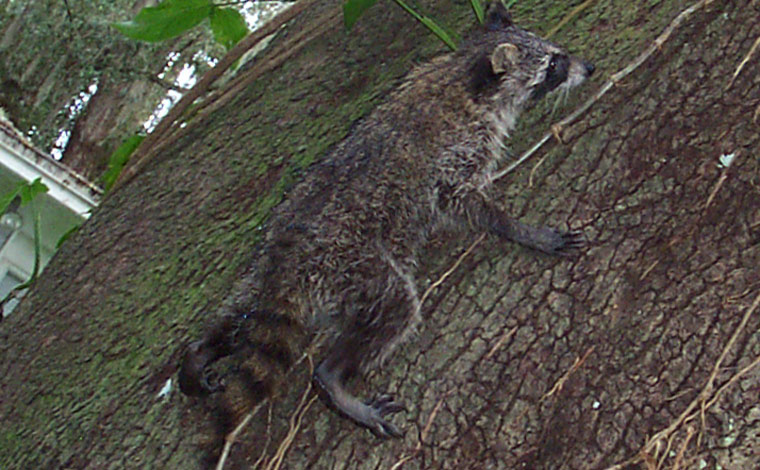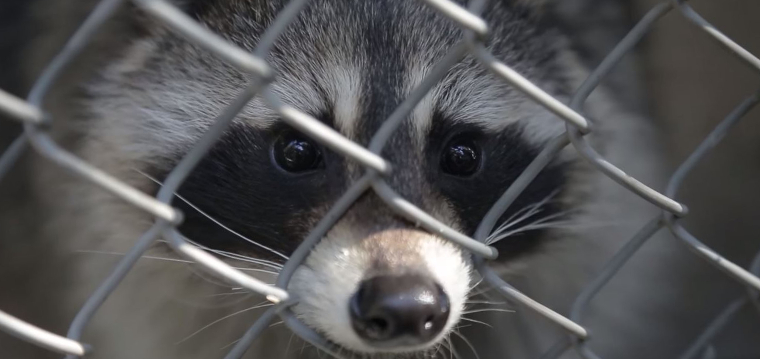-
info@aaanimalcontrol.com
Call us for help in your town
Humane Wildlife Education
Do raccoons climb fences?
Need raccoon removal in your hometown? We service over 500 USA locations! Click here to hire us in your town and check prices - updated for year 2020.
About the same size as the average house cat, the humble raccoon can grow to about three foot in length. They’re not exactly small creatures, so you would be forgiven for thinking they were also quite clumsy. They sure sound that way, while they’re thumping away in the attic above your head, or making racket in the back garden whilst rooting through your garbage can.

These creatures usually live near water, in areas where there are plenty of trees. The trees are what give the raccoon protection when needed, from predators. The trees also provide hollows, which the raccoons love to sleep in. Sadly, many of these places are no longer on offer to the wild raccoon, and they’ve had no choice but to essentially move right in with us - humans.
Although not a fence, a tree isn’t far off. If a raccoon can climb a tree with relative ease, they won’t have much of a problem climbing a wooden fence, and this will be more so the case if it has a textured surface. The two front feet of the raccoon have dexterous toes - five of them to be precise, and these help the animal to cling on and climb higher.
If you have a fence around your property, or even your backyard , it is probably not going to be enough of a fence to keep various wild animals out. Bats and birds can fly overhead, snakes can slither underneath, various creatures, such as moles, can also burrow underground, and even squirrels and raccoons can climb and clamber. There is no foolproof way of keeping all animals out of your yard. The trick is to keep them out of your house, and also to make your yard look as unattractive as possible. This means to take out all food sources that could be enticing raccoons and other animals in, as well as removing all piles of debris and trash. These make for great homes for the average homeless wild animal. If you have suck things just lying around on your land, you are simply asking to be invaded by something. If it’s not a raccoon, it’ll be something else - a skunk, an opossum, squirrels, rats, mice …
If you think you do have a raccoon climbing your fence, it will usually be one of two reasons. It’s either climbing to the top of the fence to clamber across it and get to the higher levels of your home. Take a peek - can a raccoon get across the fence and onto your roof? Could a tree trunk or tree branch be helping it along? If the answer is yes, you’ll need to trim them back.
Other tracks that you are likely to see in your garden if a raccoon is climbing the face, are marks in the soft floor - soil, mud, sand, etc. The fence is also likely to have scratch-claw marks, or maybe even dirty smear patches. This will be where the raccoon has been moving around, and the fur has been dragged across the surface. You may also find small hairs that once belonged to the raccoon, and perhaps even droppings lying around on the floor too. You'll likely spot them - they are usually around three to five inches in length, if you have an adult raccoon on your hands. They’re basically the same size as most cat and dog droppings.
5 Simple Tricks to Get Raccoons out of the Back Yard
Need raccoon removal in your hometown? We service over 500 USA locations! Click here to hire us in your town and check prices- updated for year 2020.
Raccoons in the back yard mean three things:
1 - A mess.
2 - Damage to your property.
3 - Disease threats to you, your family, and your pets/animals.
We could probably add another one to that list too:
4 - Lots of stress and wasted time/energy.
The good news is that there are more than a few ways that you can TRY to get rid of raccoons that are hanging around and causing your problems. The bad news is that it might take you a while, is likely to cost you a fair bit, and will leave you frustrated more often than not.
With raccoons, you might find that it is both in your best interests and cheaper to just hire in wildlife rehabilitators to do the job for you.

It's not so much making your home raccoon-proof that is so difficult; that's the easy part. It is getting rid of the animal itself that proves rather difficult. One raccoon will usually mean a number of raccoons — a mother with her young (kits) in a nest (also known as a den).
You can't remove the mother with the babies; otherwise, the babies will just die. You can't remove the babies without the mother because that doesn't get rid of the problem at all. You can grab the babies and pop them in a live cage trap, if you can find them and they're easily reached. You then have a slightly higher chance of getting the mother into the trap, giving you the chance to 'dispose' of the entire family in whichever way you have chosen or is legal for your state/area.
Once the animals are gone, sorting out the rest of the problem is relatively easy. You must fix all damage, cleanup any mess (although, this can be dangerous and, just like removal, is best left to the experts in heavy cases), before then working your magic to “raccoon-proof” your back yard.
5 Simple Tricks to Get Raccoons out of the Back Yard
1 - Remove all sources of food.
Food is what encourages these animals to take a closer look, so when you take the source of food away, you are taking away the attractant. You are also taking away the thing that made their den spot worth sticking around for. Raccoons are well known to move their babies from one spot to another. If your back yard — their current den site — is no longer known for having a decent supply of food, the family will move along to find a place that does.
2 - Remove all hiding spots.
Just like food, hiding spots are what these creatures are looking for. When you take them away, the animal has nowhere to cower when the going gets tough.
Hiding spots in your garden could be a quick hiding spot or a nesting site. You will want to take both options away. Piles of garden debris, rocks, wood, or anything else should be removed. Stuff that is left lying around should be put away. The more open and clear your garden is, the fewer hiding spots the raccoon will be able to utilize. Wild animals don't much appreciate being exposed to predators and other dangers. They would much prefer to hide in the shadows of a messy back yard.
3 - Erect a fence.
Raccoons are stubborn, determined, and very intelligent, but they are also something else — a little on the lazy side. They would much prefer to eat food that has been killed by another animal and then left behind, than chase an animal down and go through the hassle of killing it. The more work they need to do, the more energy they waste and that energy could be better spent elsewhere.
A fence that has been erected around your back yard will protect your land, but only as long as you remember to protect underground as well as overground — raccoons can dig and they are very, very good at it.
4 - Install solar-powered intruder lights.
Raccoons are nocturnal animals and despite being pretty confident animals when it comes to accepting food from people, they are usually rather shy animals. Shining a light directly at the raccoon at night will definitely scare the critter away, so solar-powered intruder lights can offer something in the way of protection. This doesn't help you during the day, but raccoons are less likely to be rummaging around in your back yard during broad daylight.
5 - Monitor the situation.
By knowing what is going on in your back yard, you'll have a good idea of how to stop any potential problems that arise. If you know, for example, that a section of your fence has become damaged and is starting to allow wildlife to get in, you can repair it. You might even look at adding additional protection while you're there, such as adding that underground layer that we discussed previously.
Regular inspections will allow you to see everything — potential entry points or areas that look as they might need some TLC, paw prints, feces or urine stains that have been left behind, and even the remnants of a meal; all signs that you have an animal intruder that needs to be evicted.
The sooner you spot these problems, the less they will cost you to not only get rid of, but also put right after. By monitoring the situation and inspecting/taking care of your home, you can put extra preventative measures in place.
For more information, you may want to click on one of these guides that I wrote:
How much does raccoon removal cost? - get the lowdown on prices.
How to get rid of raccoons - my main raccoon removal info guide.
Example raccoon trapping photographs - get do-it-yourself ideas.
Raccoon job blog - learn from great examples of raccoon jobs I've done.
raccoons in the attic
Raccoons & Bird Feeders: How to Keep Them Out


















